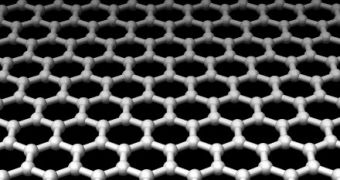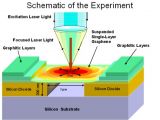This wonderous material called graphene was discovered in 2004 and quickly became one of the top contenders for the development of future ultrafast computer chips. It has an extremely good electrical conductivity, is a semiconductor and, last but not least, can be fashioned into very thin membranes. Recently, US researchers discovered possibly one of the most important property of the graphene: the capability of good thermal conductivity.
Amazingly, to measure the thermal coefficient of the material, scientists had to invent a way to do so, and are currently studying the possibility of using the properties of the graphene to cool ultrafast silicon computer chips.
Being made out of carbon, it was natural for scientists to suspect that graphere is able to conduct heat as well as carbon nanotubes. Albeit determining its thermal properties is no easy feat, considering that graphene is a difficult to work with material and the usual method applied in measuring thermal coefficients involve the use of heaters and a series of additional instruments on its surface.
Nonetheless, the procedure of measuring the graphene temperature proved to be relatively easy for Alexander Balandin from the University of California-Riverside, who used a laser system both to heat up the material and to receive feedback related to the temperature. Graphene sheets were suspended on trenches of a silicon-oxide surface, measuring only a micrometer across. The sheets were pined down at both ends by graphene layers, which also had the role of heat sinks.
In order to heat up the material, US scientists shone a beam of laser on the surface of the graphene, thus they changed the vibration frequency of the carbon atoms inside the graphene crystal. A change in vibration frequency ultimately translates into the appearance of Raman scattering of vibrating atoms, which can be translated directly into a temperature reading by measuring the frequency shift. During the experiment, data revealed that, at room temperature, the graphene experiences a thermal conductivity of 5300 pW, which is currently the highest thermal coefficient measured on a solid material.
Although theoretical calculations clearly showed that this is possible, Baladin recognized that the team were actually surprised of their findings. Graphene has a thermal conductivity about 50 percent higher than that of carbon nanotubes, and ten times higher than metals, such as copper and aluminum. This particular property seems to be the result of a so-called ease in the atomic vibration inside the crystal, but the team are not certain yet and are still working on their theory.

 14 DAY TRIAL //
14 DAY TRIAL // 
